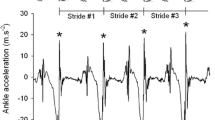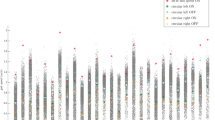Abstract
In healthy people, energy expenditure is generally higher during walking with poles (WP) than during conventional walking (W). In persons with Parkinson’s disease (PD), walking is slower and may be associated with greater energy consumption, stride-to-stride variability, and difficulty in regulating stride length. The aim of this study was to determine whether treadmill WP at three different speeds could induce changes in gait kinematics and oxygen consumption in PD patients. The study sample was 20 patients with mild-to-moderate PD and 20 age-matched healthy controls. Subjects underwent 5-min W and WP treadmill tests at three different speeds (2.5, 3.5, and 4.5 km/h). Metabolic and gait parameters (ventilation, gas exchange, stride count and length) were recorded. As compared with the healthy controls, higher energy consumption (P < 0.05) (and other metabolic parameters), shorter stride, and reduced cadence (P < 0.05) were observed for the PD patients, independent of the walking technique. All subjects were noted to take longer strides during WP (P < 0.001), especially at the lowest treadmill speed. However, significantly higher energy consumption was observed only for the healthy controls (P < 0.05). No changes in metabolic parameters during WP were recorded; however, a substantial improvement in gait cycle length was noted for the PD patients.


Similar content being viewed by others
References
Shenkman M, Hall DA, Baron AE, Schwartz RS, Mettler P, Kohrt WM (2012) Exercise for people in early-or-mid stage Parkinson disease: a 16-month of randomized controlled training. Phys Ther 11:1395–1410
Canning CG, Ada L, Johnson JJ, McWhirter S (2006) Walking capacity in mild to moderate Parkinson’s disease. Arch Phys Med Rehabil 87:371–375
Cugusi L, Solla P, Serpe R, Carzedda T, Piras L, Oggianu M, Gabba S, Di Blasio A, Bergamin M, Cannas A, Marrosu F, Mercuro G (2015) Effects of a Nordic walking program on motor and non-motor symptoms, functional performance and body composition in patients with Parkinson’s disease. NeuroRehabilitation 37:245–254
Morris ME (2006) Locomotor training in people with Parkinson disease. Phys Ther 86:1426–1435
Bombieri F, Schena F, Pellegrini B, Barone P, Tinazzi M, Erro R (2017) Walking on four limbs: a systematic review of Nordic walking in Parkinson disease. Parkinson Relat Disord 38:8–12
Ellis T, Goede CJ, Feldman R, Wolters EC, Kwakkel G, Wageenar RC (2005) Efficacy of a physical therapy program in patients with Parkinson’s disease: a randomized clinical trial. Arch Phys Med Rehabil 4:626–632
Tan D, Danoidus M, McGinley G, Morris ME (2012) Review. Relationships between motor aspects of gait impairments and activity limitations in people with Parkinson’s disease: a systematic review. Parkinson Relat Disord 18:117–124
Remisse S, Muller F, Bannier S, Pujol S, Viollier-Fears S, Dehail P, Ellie E (2016) Interest of a physical activity program including Nordic walking in idiopathic Parkinson’s disease. Ann Phys Rehabil Med 59S:e57
Morris ME, Iansek R, Matyas T, Summers JL (1994) The pathogenesis of gait hypokinesia in Parkinson’s disease. Brain 117:1169–1181
Morris ME, Iansek R (1996) Characteristics of motor disturbance in Parkinson’s disease and strategies for movement rehabilitation. Hum Mov Sci 15:649–669
Gougeon MA, Zhou L, Nantel J (2017) Nordic walking improves trunk stability and gait spatial-temporal characteristics in people with Parkinson disease. NeuroRehabilitation. doi:10.3233/NRE-171472
Morris ME, Iansek R, Matyas TA, Summers JJ (1996) Stride length regulation in Parkinson’s disease: normalization strategies and underlying mechanisms. Brain 119:551–568
Reuter I, Mehnert S, Leone P, Kaps M, Oeschner M, Elgenhardt M (2011) Effects of a flexibility and a relaxation programme, walking, and Nordic walking on Parkinson’s disease. J Aging Res. doi:10.4061/2011/232473
Maggioni MA, Veicsteinas A, Rampichini S, Cè E, Nemni R, Riboldazzi G, Merat G (2012) Energy cost of spontaneous walking in Parkinson’s disease patients. Neurol Sci 33:779–784
Protas EJ, Stanley RK, Jankovic J, MacNeill B (1996) Cardiovascular and metabolic responses to upper- and lower-extremity exercise in men with idiopathic Parkinson’s disease. Phys Ther 76:34–40
Bello O, Fernandez-Del-Olmo M (2012) How does treadmill affect gait in Parkinson’s disease? Curr Aging Sci 5:28–34
Herfurth M, Godau J, Kattner B, Rombach S, Grau S, Maetzler W, Berg D (2015) Gait velocity and step length at baseline predict outcome of Nordic walking training in patients with Parkinson’s disease. Parkinson Relat Disord 21:413–416
Bello O, Marquez G, Camblor M, Fernandez-Del-Olmo M (2010) Mechanisms involved in treadmill walking improvements in Parkinson’s disease. Gait Posture 32:118–123
Monteiro EP, Franzoni LT, Cubillos DM, de Oliveira Fagundes A, Carvalho AR, Oliveira HB, Pantoja PD, Schuch FB, Rieder CR, Martinez FG, Peyré-Tartaruga LA (2016) Effects of Nordic walking training on functional parameters in Parkinson’s disease: a randomized controlled clinical trial. Scand J Med Sci Sports 27(3):351–358
Pellegrini B, Peyre-Tartaruga L, Zoppirolli C, Bortolan L, Bacchi E, Figard-Fabre H, Schena F (2015) Exploring muscle activation during Nordic walking: a comparison between conventional and uphill walking. PLoS One. doi:10.1371/journal.pone.0138906
van Eijkeren FJM, Reijmers RFJ, Kleinveld MJ, Minten A, Bruggen JP, Bloem BR (2008) Nordic walking improves mobility in Parkinson’s disease. Mov Disord 23(15):2239–2243
Christiansen CL, Schenkman ML, McFann K, Wolfe P, Kohrt WM (2009) Walking economy in people with Parkinson’s disease. Mov Disord 24(10):1481–1487
Pelosin E, Faelli E, Lofrano F, Avanzino L, Marinelli L, Bove M, Ruggeri P, Abbruzzese G (2009) Effects of treadmill training on walking economy in Parkinson’s disease: a pilot study. Neurol Sci 30:499–504
Warlop T, Detrembleur C, Buxes Lopez M, Stoquart G, Lejeune T, Jeanjean A (2017) Does Nordic walking restore the temporal organization of gait variability in Parkinson’s disease? J Neuroeng Rehabil 14(1):17
Figard-Fabre H, Fabre N, Leonardi A, Schena F (2010) Physiological and perceptual responses to Nordic walking in obese middle-aged women in comparison with the normal walk. Eur J Appl Physiol 108:1141–1151
Tschentscher M, Niederseer D, Niebauer J (2013) Health benefits of Nordic walking. A systematic review. Am J Prev Med 44(1):76–78
Church TS, Earnest CP, Morss GM (2002) Field testing of physiological responses associated with Nordic walking. Res Q Exerc Sport 73(3):296–300
Wass E, Taylor NF, Matsas A (2005) Familiarisation to treadmill walking in unimpaired older people. Gait Posture 21(1):72–79
Morgulec-Adamowicz N, Marszalek J, Jagustin P (2011) Nordic walking—a new form of adapted physical activity (a literature review). Hum Mov Sci 12(2):124–132
Acknowledgements
We would like to thank Elisa Casagrande and Elisa Grottolo for their help in data collection, and the subjects for participating in the study.
Author information
Authors and Affiliations
Corresponding author
Ethics declarations
Funding
No funding was received for this work.
Conflicts of interest
The authors report no conflict of interest.
Rights and permissions
About this article
Cite this article
Nardello, F., Bombieri, F., Tinazzi, M. et al. Metabolic and kinematic parameters during walking with poles in Parkinson’s disease. J Neurol 264, 1785–1790 (2017). https://doi.org/10.1007/s00415-017-8568-y
Received:
Revised:
Accepted:
Published:
Issue Date:
DOI: https://doi.org/10.1007/s00415-017-8568-y




